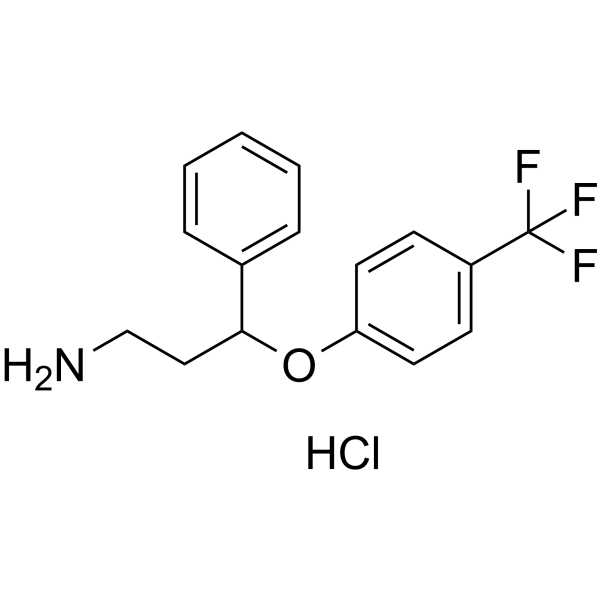Norfluoxetine hydrochloride

Norfluoxetine hydrochloride structure
|
Common Name | Norfluoxetine hydrochloride | ||
|---|---|---|---|---|
| CAS Number | 57226-68-3 | Molecular Weight | 331.760 | |
| Density | 1.204g/cm3 | Boiling Point | 381.1ºC at 760 mmHg | |
| Molecular Formula | C16H17ClF3NO | Melting Point | N/A | |
| MSDS | USA | Flash Point | 184.3ºC | |
Use of Norfluoxetine hydrochlorideNorfluoxetine hydrochloride is an active N-demethylated metabolite of Fluoxetine. Fluoxetine is a selective serotonin (5-HT) reuptake inhibitor that is metabolized to Norfluoxetine hydrochloride by cytochrome P450 (CYP) 2D6, CYP2C19, and CYP3A4. Norfluoxetine hydrochloride inhibits 5-HT uptake and inhibits CaV3.3 T current (IC50 = 5 μM). Norfluoxetine hydrochloride has anticonvulsant activity[1][2][3][4]. |
| Name | Norfluoxetine hydrochloride |
|---|---|
| Synonym | More Synonyms |
| Description | Norfluoxetine hydrochloride is an active N-demethylated metabolite of Fluoxetine. Fluoxetine is a selective serotonin (5-HT) reuptake inhibitor that is metabolized to Norfluoxetine hydrochloride by cytochrome P450 (CYP) 2D6, CYP2C19, and CYP3A4. Norfluoxetine hydrochloride inhibits 5-HT uptake and inhibits CaV3.3 T current (IC50 = 5 μM). Norfluoxetine hydrochloride has anticonvulsant activity[1][2][3][4]. |
|---|---|
| Related Catalog | |
| Target |
5-HT Receptor Cav3.3:5 μM (IC50) |
| In Vivo | Pretreatment with Fluoxetine or Norfluoxetine hydrochloride (20mg/kg s.c.), as well as Phenytoin (30 mg/kg s.c.) and Clonazepam (0.1mg/kg s.c.) significantly increases both the rate and duration of survival, demonstrating a significant protective effect against Pentylenetetrazol-induced epilepsy[1]. |
| References |
| Density | 1.204g/cm3 |
|---|---|
| Boiling Point | 381.1ºC at 760 mmHg |
| Molecular Formula | C16H17ClF3NO |
| Molecular Weight | 331.760 |
| Flash Point | 184.3ºC |
| Exact Mass | 331.095062 |
| PSA | 35.25000 |
| LogP | 5.67660 |
| Water Solubility | H2O: >4 mg/mL |
| Personal Protective Equipment | Eyeshields;Gloves;type N95 (US);type P1 (EN143) respirator filter |
|---|---|
| RIDADR | NONH for all modes of transport |
| WGK Germany | 3 |
|
K2P channel gating mechanisms revealed by structures of TREK-2 and a complex with Prozac.
Science 347(6227) , 1256-9, (2015) TREK-2 (KCNK10/K2P10), a two-pore domain potassium (K2P) channel, is gated by multiple stimuli such as stretch, fatty acids, and pH and by several drugs. However, the mechanisms that control channel g... |
|
|
The pH-dependent toxicity of basic pharmaceuticals in the green algae Scenedesmus vacuolatus can be explained with a toxicokinetic ion-trapping model.
Aquat. Toxicol. 101(1) , 266-75, (2011) Several previous studies revealed that pharmaceuticals with aliphatic amine function exhibit a higher toxicity toward algae than toward other aquatic organisms. Here we investigated the pH-dependent t... |
|
|
Sequential metabolism of secondary alkyl amines to metabolic-intermediate complexes: opposing roles for the secondary hydroxylamine and primary amine metabolites of desipramine, (s)-fluoxetine, and N-desmethyldiltiazem.
Drug Metab. Dispos. 38(6) , 963-72, (2010) Three secondary amines desipramine (DES), (S)-fluoxetine [(S)-FLX], and N-desmethyldiltiazem (MA) undergo N-hydroxylation to the corresponding secondary hydroxylamines [N-hydroxydesipramine, (S)-N-hyd... |
| 3-phenyl-3-[4-(trifluoromethyl)phenoxy]propan-1-amine,hydrochloride |
| Benzenepropanamine, γ-(4-(trifluoromethyl)phenoxy)-, hydrochloride |
| 3-Phenyl-3-[4-(trifluoromethyl)phenoxy]-1-propanamine hydrochloride (1:1) |
| Benzenepropanamine, γ-[4-(trifluoromethyl)phenoxy]-, hydrochloride (1:1) |